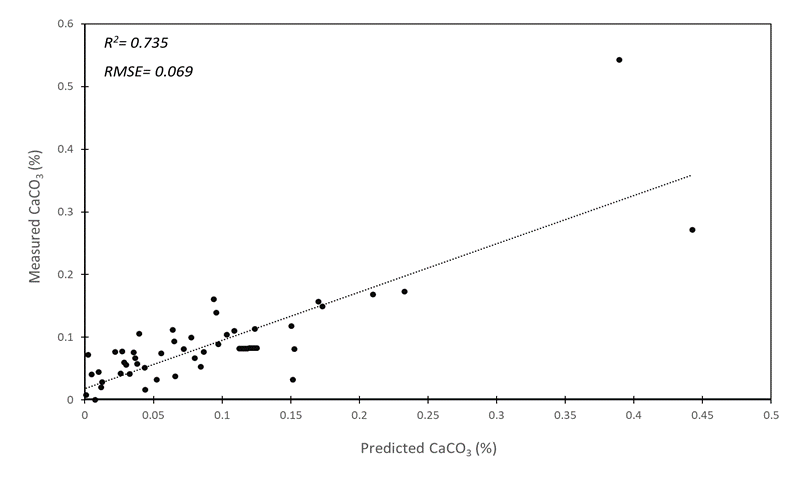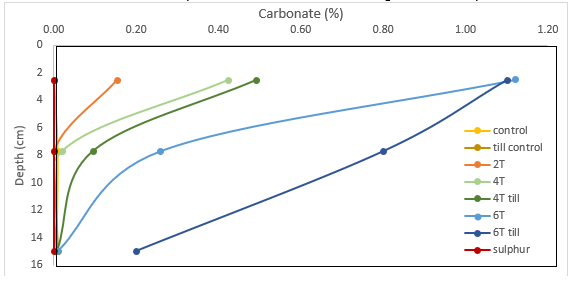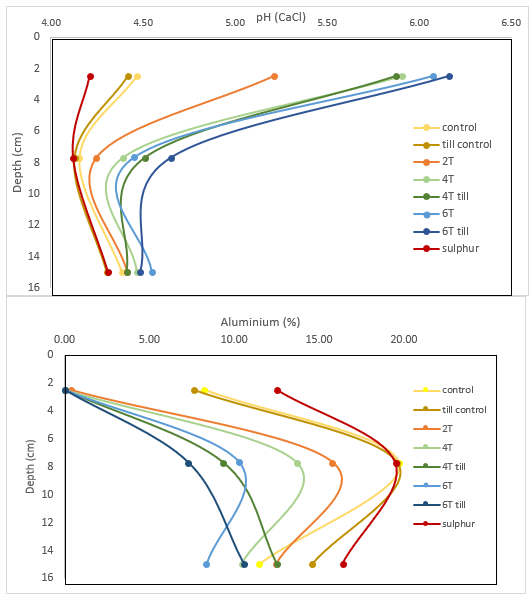Detection of lime in acidic soils using mid infrared spectroscopy
Take home messages
- Acidification of surface and subsurface soils is increasing in South Australia due to increasing productivity and use of fertiliser nitrogen.
- Soil pH is often highly variable within a paddock and requires detailed monitoring for effective management.
- Infrared spectroscopy technology may reduce the labour and soil analysis costs of assessment across paddocks and down the soil profile, improving precision management of soil acidification.
- Detection and prediction of inorganic carbon with can be used to measure agricultural lime in soils and to monitor lime movement, assisting with management of acidic soils.
- Infrared spectroscopy is a viable alternative to traditional laboratory methods.
Background
This work details PhD research undertaken as part of the GRDC-supported project, ‘New knowledge and practices to address topsoil and subsurface acidity under minimum tillage cropping systems of South Australia’ (Acid Soils SA), which aims to generate new information regarding lime movement and its effectiveness when applied to different soils and environments in modern farming systems. The focus of this component is the use of novel spectroscopic methods to improve the identification and management of soil acidification.
South Australia’s (SA) cropping zone is becoming increasingly affected by soil acidity, particularly in productive cropping rotations with high yields and high nitrogen fertiliser inputs. If left untreated, soil acidification can lead to reduced crop yields, particularly for acid sensitive, high-value crops such as legumes. Acidification of soils in the subsurface, generally between 5 and 15cm below the soil surface, is increasing in farming systems and, similarly to surface acidity, is detrimental to crop productivity (Tang et al.2013; Whitten et al. 2000).
The most commonly used treatment for soil acidification is the addition of agricultural lime, which increases soil pH and reduces exchangeable aluminium concentrations, and consequently increases crop yields (Conyers et al. 2003; Scott et al. 2000). Liming is generally most effective in the acidic soil layer where it is applied, and so surface acidity can be managed via topdressing liming materials. Mapping of pH has proved useful in identifying the distribution of pH at the soil surface and enabling targeted lime applications, but measuring and treating subsurface acidity and stratified acid layers is often more challenging, and these issues are often not detected with current soil testing methods. While some research has explored ameliorating subsurface acidity by using high surface lime rates or incorporating lime into subsurface layers, the effectiveness of these approaches to increase the soil pH at depth is often more difficult and costly to measure. There is a need for improved cost-effective methods to measure pH changes at small spatial distances and to monitor lime movement in the soil profile without undertaking extensive laboratory-based soil testing, which is often time-, energy- and cost-intensive.
Soil analysis has begun to move from complex laboratory physical and chemical analytical procedures towards more rapid and simple spectroscopic methods that have the potential to be effective in the field. A common spectroscopic method for the measurement of multiple soil properties is infrared (IR) spectroscopy. Infrared spectroscopy utilises radiation in the 700–25000nm wavelength region (near infrared (NIR): wavelength 700–2500nm, wave number 14000–4000cm-1 and mid infrared (MIR): wavelength 2500–25000nm, wave number 4000–400cm-1) of the electromagnetic spectrum (Soriano-Disla et al. 2014). There is a relationship between the chemical composition of a sample and the spectrum measured in the IR region, whereby samples with different chemical compositions will have different infrared spectra (Janik et al. 1998; Viscarra Rossel et al. 2006). Infrared spectroscopy works on the principle that the absorbance or reflectance values reported by a spectrometer do not directly measure an element but instead measure the various bonds associated with that element within the IR spectrum. The content of an element is then inferred by the relationship developed in the chemometric model. Infrared spectroscopy offers minimal sample preparation and rapid scan time. It is relatively easy to use and has the potential to analyse soil properties in real-time.
Of relevance for the management of soil acidification is the potential of IR spectroscopy to detect and quantify carbonate (used interchangeably with ‘lime’ for the purposes of this paper) present in soil, and to trace the dissolution and/or movement of lime down the soil profile. Carbonates have distinct spectral features in the IR region and can be readily identified and quantified. While IR spectroscopy has been used to measure naturally occurring carbonates in soils (generally present at concentrations >>1%), this method has not been explored in an agricultural context, where lime is applied to acidic soils and generally present at concentrations <<1%. This research explores the ability of mid infrared spectroscopy to measure low concentrations of lime in acidic soils, and to combine this information with other soil properties, to improve management of subsurface acidity.
Methods
The initial stages of this work were to develop a method to detect agriculturally relevant concentrations of lime in soil using MIR spectroscopy measurements in the laboratory. Based on current recommended liming rates, it was hypothesised that carbonate concentrations of less than 1% would need to be detectable for this technology to be useful in management of soil acidification. In order to achieve this, predictive models were established to measure carbonate concentrations of soil from spectral data. Acidic soil samples that had been limed were dried and sieved (<2mm) and fine ground (<0.1mm) before MIR spectra were obtained. Carbonate concentration was measured using a pressure calcimeter method, and partial least square regression (PLSR) models were derived from the MIR spectra and reference calcimeter data for the prediction of carbonate content. Details of this method are provided in Hume et al. (2022).
This new method is now being applied to a number of field trials that have been established as part of the Acid Soils SA project, to measure the concentration of undissolved lime in the soil profile. Each trial site comprises four replicate blocks containing trial treatments with various lime sources, rates and incorporation methods. Intensive soil sampling was undertaken at a number of the trial sites whereby soil cores were collected from selected treatments within each replicate block at depths of 0-5cm, 5-10cm and 10-20cm. Treatments selected for sampling were those with different rates of lime (2t/ha, 4t/ha and 6t/ha) and different lime application methods (surface applied or incorporated with a tyned cultivator to 10cm).
The soil samples were analysed with traditional laboratory methods to determine pH (CaCl2) and exchangeable aluminium levels, and also scanned with a lab-based MIR spectrometer. The MIR carbonate prediction method (Hume etal. 2022) was used to measure concentrations of undissolved lime in the soil at these sites. Preliminary results are provided for one trial site (Sandilands, Yorke Peninsula, South Australia — loamy sand with ironstone gravel over red clay) and further data for other trial sites is currently being processed.
Results and discussion
Carbonate prediction at agriculturally relevant concentrations
Figure 1 depicts the predictive capability (relationship between laboratory measured and MIR-predicted carbonate content) of the MIR method. The R2 value of 0.735 confirms the potential of this method for the prediction of carbonate content in acidic soils that contain additions of lime.

Figure 1. Carbonate predictive validation results showing predicted carbonate versus measured carbonate (%) of field collected soils (acidic soils treated with lime) in the MIR spectral ranges 2560-2460cm-1.
The data in Figure 2 provides an example of potential application of this MIR method to detect carbonate in an agricultural context. Two soil profiles, one limed and one un-limed, collected from a trial site used in the acid soils project (Wirrabara, South Australia — sandy loam over brown clay) are presented with predicted carbonate concentrations at 25mm intervals. The limed soil was treated in 2015 with a surface application of lime at a rate of 6t/ha, and the presence of lime down to approximately 100mm can clearly be detected. This highlights the potential of this method as a tool for monitoring lime presence and movement in acidic soils.
Figure 2. Example of application of the MIR method to detect carbonate in a soil profile at the Wirrabara trial site for an un-limed and a limed soil. The limed soil was treated with surface applied lime at a rate of 6t/ha in 2015.
Application of method at field trials
Figure 3 depicts the 2021 carbonate concentrations of soils collected from the Sandilands trial site which was treated in 2019 with lime at rates of 2, 4 and 6t/ha, and either surface applied or incorporated with a tyned cultivator to 10cm. An elemental sulphur treatment is also included to mimic continued acidification of the soil. This figure highlights where undissolved lime is located in the soil and, when combined with other information about each treatment (such as pH and Al), gives an indication about the efficacy of the treatments at remediating the soil acidity.
Figure 3. Soil carbonate content, pH and aluminium content (measured in 2021) in relation to lime rate and incorporation treatments with lime at Sandilands trial site. Loamy sand with ironstone gravel over red clay. Soil was limed in 2019 at rates of 2, 4 and 6t/ha and lime was surface applied or incorporated with a tyned cultivator to 10cm (till).
Conclusion
This study provides a proof of concept for the use of MIR spectroscopy to measure low concentrations of carbonate additions to soil. The use of this method in soils that have been limed may enable the measurement of carbonate content and detection of carbonate movement in acidic soils at fine spatial scales. By measuring lime movement through acidic soils, we propose that MIR spectroscopy undertaken in controlled laboratory conditions will be useful in the monitoring and management of soil acidification in agricultural settings. Currently, this method is being utilised to measure carbonate concentrations in various trial sites established under the soil acidity SA project. It provides valuable information about the movement of lime and may be useful in ensuring that sufficient lime is applied to remediate acidity in subsurface layers.
The applicability of infrared spectroscopy under field conditions is yet to be demonstrated for this purpose, but previous studies have highlighted the capabilities of portable IR devices for accurate prediction of other soil properties such as organic C, pH, CEC and clay/sand content. As hand-held IR technology improves and costs decrease, this approach offers an appealing option where intensive soil sampling is required for effective management.
Acknowledgements
The research undertaken as part of this project is made possible by the significant contributions of growers through both trial cooperation and the support of the GRDC, the author would like to thank them for their continued support. The authors are grateful for the help of the Les Janik (formerly of CSIRO) for advice with spectral analysis, Prof. Michael McLaughlin (University of Adelaide) for provision of spectroscopic equipment, and Brian Hughes and Andrew Harding (PIRSA) for project support and advice.
References
Conyers MK, Mullen CL, Scott BJ, Poile GJ, Braysher BD (2003) Long-term benefits of limestone applications to soil properties and to cereal crop yields in southern and central New South Wales. Australian Journal of Experimental Agriculture 43(1), 71-78.
Hume R, Marschner P, Schilling RK, Mason S, Mosley LM (2022) Detection of agriculturally relevant lime concentrations in soil using mid-infrared spectroscopy. Geoderma 409, 115639.
Janik LJ, Merry RH, Skjemstad JO (1998) Can mid infrared diffuse reflectance analysis replace soil extractions? Australian Journal of Experimental Agriculture 38(7), 681–696.
Scott BJ, Ridley AM, Conyers MK (2000) Management of soil acidity in long-term pastures of south-eastern Australia: a review. Australian Journal of Experimental Agriculture 40(8), 1173-1198.
Soriano-Disla JM, Janik LJ, Rossel RAV, MacDonald LM, McLaughlin MJ (2014) The performance of visible, near-, and mid-infrared reflectance spectroscopy for prediction of soil physical, chemical, and biological properties. Applied Spectroscopy Reviews 49(2), 139–186.
Tang C, Weligama C, Sale P (2013) Subsurface soil acidification in farming systems: its possible causes and management options. In ‘Molecular environmental soil science, progress in soil science’. (Eds J. Xu, D.L. Sparks) pp. 389–412. (Springer Netherlands, Dordrecht)
Viscarra Rossel RA, Walvoort DJJ, McBratney AB, Janik LJ, Skjemstad JO (2006) Visible, near infrared, mid infrared or combined diffuse reflectance spectroscopy for simultaneous assessment of various soil properties. Geoderma 131(1-2), 59–75.
Whitten MG, Wong MTF, Rate AW (2000) Amelioration of subsurface acidity in the south-west of Western Australia: downward movement and mass balance of surface-incorporated lime after 2-15 years. Australian Journal of Soil Research 38(3), 711-728.
Contact details
Ruby Hume
The University of Adelaide, Waite Campus, Urrbrae, 5063
0419 828 939
ruby.hume@adelaide.edu.au
@rubyzhume
GRDC Project Code: UOA1905-015RTX,
Was this page helpful?
YOUR FEEDBACK



